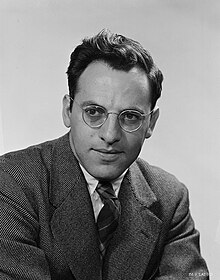
Back فريدريك راينس Arabic فريدريك راينس ARZ Frederik Raynes Azerbaijani فردریک رینز AZB Фрэдэрык Райнес Byelorussian Фредерик Рейнс Bulgarian ফ্রেডেরিক রাইনেস Bengali/Bangla Frederick Reines Catalan Frederick Reines Czech Frederick Reines Danish
Frederick Reines | |
|---|---|
 | |
| Born | March 16, 1918 Paterson, New Jersey, U.S. |
| Died | August 26, 1998 (aged 80) Orange, California, U.S. |
| Citizenship | American |
| Alma mater | New York University Stevens Institute of Technology |
| Known for | Neutrinos |
| Spouse | Sylvia Samuels (m. 1940; 2 children) |
| Awards |
|
| Scientific career | |
| Fields | Physics |
| Institutions | |
| Thesis | Nuclear fission and the liquid drop model of the nucleus (1944) |
| Doctoral advisor | Richard D. Present |
| Doctoral students | Michael K. Moe (1965) |
Frederick Reines (/ˈraɪnəs/ RY-nəs;[1] March 16, 1918 – August 26, 1998) was an American physicist. He was awarded the 1995 Nobel Prize in Physics for his co-detection of the neutrino with Clyde Cowan in the neutrino experiment. He may be the only scientist in history "so intimately associated with the discovery of an elementary particle and the subsequent thorough investigation of its fundamental properties."[2]
A graduate of Stevens Institute of Technology and New York University, Reines joined the Manhattan Project's Los Alamos Laboratory in 1944, working in the Theoretical Division in Richard Feynman's group. He became a group leader there in 1946. He participated in a number of nuclear tests, culminating in his becoming the director of the Operation Greenhouse test series in the Pacific in 1951.
In the early 1950s, working in Hanford and Savannah River Sites, Reines and Cowan developed the equipment and procedures with which they first detected the supposedly undetectable neutrinos in June 1956. Reines dedicated the major part of his career to the study of the neutrino's properties and interactions, which work would influence study of the neutrino for many researchers to come. This included the detection of neutrinos created in the atmosphere by cosmic rays, and the 1987 detection of neutrinos emitted from Supernova SN1987A, which inaugurated the field of neutrino astronomy.
- ^ Cite error: The named reference
Obituarywas invoked but never defined (see the help page). - ^ Schultz, Jonas; Sobel, Hank. "Frederick Reines and the Neutrino". University of California, Irvine School of Physical Sciences. Archived from the original on February 20, 2014.